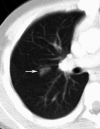Francisella philomiragia adenitis and pulmonary nodules in a child with chronic granulomatous disease
- PMID: 18159552
- PMCID: PMC2095034
- DOI: 10.1155/2005/486417
Francisella philomiragia adenitis and pulmonary nodules in a child with chronic granulomatous disease
Abstract
Francisella philomiragia is a rare and opportunistic pathogen capable of producing invasive infection in patients with compromised neutrophil function and in patients that have survived a near-drowning. A case of F philomiragia adenitis and lung nodules, refractory to cephalosporin therapy, is reported in a 10-year-old boy with chronic granulomatous disease following a facial abrasion from a saltwater crab. To the authors' knowledge, this is the first Canadian clinical isolate to be reported. Genus and species identification was confirmed via 16S ribosomal RNA sequence analysis. A literature review revealed three groups at risk of F philomiragia infection: young patients with chronic granulomatous disease; adults with hematogenous malignancy; and near-drowning patients. Pneumonia, fever without an apparent source and sepsis are the main clinical presentations. Invasive procedures may be required to isolate this organism and ensure appropriate antimicrobial therapy. Limited awareness of F philomiragia has led to delayed identification, patient death and misidentification as Francisella tularensis - a biosafety level three pathogen and potential bioterrorism agent.
Keywords: Chronic granulomatous disease; Francisella philomiragia.
Figures




References
-
- Wenger JD, Hollis DG, Weaver RE, et al. Infection caused by Francisella philomiragia (formerly Yersinia philomiragia). A newly recognized human pathogen. Ann Intern Med 1989;110:888-92. - PubMed
-
- Sicherer SH, Asturias EJ, Winkelstein JA, Dick JD, Willoughby RE. Francisella philomiragia sepsis in chronic granulomatous disease. Pediatr Infect Dis J 1997;16:420-2. - PubMed
-
- Polack FP, Harrington SM, Winkelstein JA, Merz WG, Willoughby RE. Recurrent Francisella philomiragia sepsis in chronic granulomatous disease. Pediatr Infect Dis J 1998;17:442-3. - PubMed
Publication types
LinkOut - more resources
Full Text Sources

